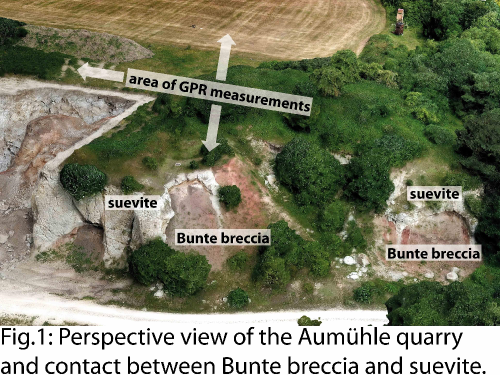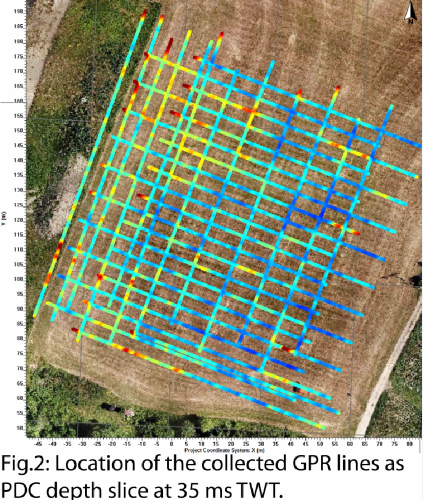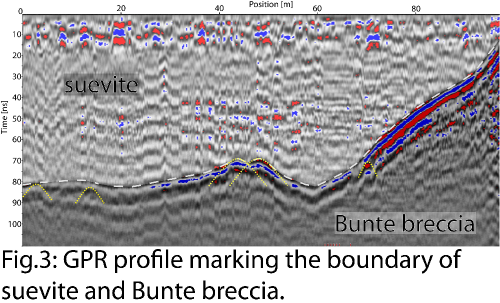EPSC Abstracts
Vol.14, EPSC2020-1120, 2020
https://doi.org/10.5194/epsc2020-1120
Europlanet Science Congress 2020
© Author(s) 2020. This work is distributed under the Creative Commons Attribution 4.0 License.
Ground-penetrating radar (GPR) of the Ries crater's ejecta blanket at Aumühle
- 1Institute of Earth and Environmental Sciences (Near-Surface Geophysics), Alberst-Ludwigs-University Freiburg, Germany (jakob.wilk@geologie.uni-freiburg.de)
- 2Institute of Earth and Environmental Sciences (Geology), Alberst-Ludwigs-University Freiburg, Germany
Introduction:
The Ries crater is a 26 km sized complex impact structure of Miocene origin (14.34+-0.08 Ma) [1, 2]. The impact event itself was caused by an oblique impact of a 1.5 km diameter stony meteorite exceeding an impact velocity of 15 km s-1 [3] The impact occurred in a two-layered target of crystalline rocks (mainly granites, gneisses and amphibolites) overlain by ~650 m thick, partly water-saturated, sedimentary cover of Tertiary, Jurassic and Permian shale, sand- and limestones [4]. The ejecta material builds up a continuous polymict lithic breccia, called Bunte breccia, with unshocked to weakly shocked sedimentary target clasts, reworked surficial sediments, and minor amounts of crystalline basement fragments [5], overlain by patches of shocked and partly melted crystalline basement material, called suevite [6, 7]. This succession of Bunte breccia and suevite is typically presented as an undulating contact, strikingly exposed for instance in the Aumühle quarry near the NE crater rim of the Ries (Fig.1).

Different formation models have been proposed for the emplacement of the Bunte breccia. One possible mechanism includes rampart formation similar to the formation of Martian rampart craters [8-12], which typically show a characteristic thickening (rampart) and thinning (moat) of the inner and outer ejecta deposits and radially oriented grooves and ridges (“striations”) [14, 15]. We hypothesize: groves and ridges present in the Ries ejecta can be traced in the scale of the Aumühle quarry by the undulating contact of Bunte breccia and suevite radially extending into a striation-like subsurface morphology.
Methods:
For characterizing the lateral extend of the undulated contact plane between Bunte breccia and suevite, we carried out a geophysical survey in 2019 for the surrounding area of the Aumühle quarry. In addition, we conducted a photogrammetric drone mapping for the entire quarry and its surrounding.
For the geophysical survey, in total 34 GPR profiles were collected (Fig.2) with a bi-static, common-offset, sled mounted, and unshielded 200 MHz antenna equipped with a pulseEKKO Pro transmitter and a pulseEKKO receiver unit (Sensors & Software). The antennas were oriented perpendicular broadside, with an antenna separation of 0.5 m. Traces along the GPR-profiles were recorded with a spacing of 0.2 m, triggered by an odometer wheel attached to the rear of the sled.

In order to corroborate the GPR measurements, electric resistivity measurements were carried out parallel to the quarry walls. For the resistivity measurements, profiles with a profile length of 117.5 m in a Wenner-Schlumberger array configuration were made, using 48 electrodes, with an electrode spacing of 2.5 m, connected to a Syscal Junior.
A DJI Mavic Pro drone was used in order to conduct the photogrammetric study and subsequently generating digital elevation models (DEMs) and orthoimages using Agisoft PhotoScan software.
Results and Discussion:
The Aumühle quarry shows an undulating and sharp contact between Bunte breccia and suevite whose relief amplitude is in the order of 5-10 m. The striations are a few meters wide and several meters deep.

The GPR profiles clearly trace the boundary layer between both units and indicate a continuation of the undulated surface of the Bunte breccia at the subsurface (Fig.3). At the current state, reflection events in the subsurface markedly differ in reflected signal energy (Fig.2) which makes it implausible to correlate the original surface of the Bunte breccia over large areas based on reflected energy. However, we intend to construct an area-wide reconstruction of the boundary layer based on individual diffraction events to generate an interpolated surface of the Bunte breccia.
Acknowledgments:
We thank the “Wissenschaftliche Gesellschaft, Freiburg im Breisgau” for funding the field trip to Ries crater and Prof. F. Preusser and Dr. J. Miocic for providing and introducing the drone. We are grateful to M.Sc students Emir Öge and Hamdy Habib for their diligent assistance.
References:
[1] Laurenzi M. A et al. (2003) Meteoritics & Planet. Sci., 38, 887-894. [2] Buchner E. et al. (2003) Int J. Earth Sci, 92,1-6. [3] Stöffler D. et al. (2002) Meteoritics & Planet. Sci., 37, 1893-1907. [4] Pohl J. et al. (1977) In: Impact and explosion cratering, Pergamon Press, New York, 343–404. [5] Hörz F. et al. (1983) Reviews of Geophysics and Space Physics, 21, 1667-1725. [6] Stöffler D. 1977 Geologica Bavarica, 75, 443-458. [7] Von Engelhardt W. 1997 Meteoritics & Planet. Sci., 32, 545-554. [8] Osinski G. R. et al. 2004 Meteoritics & Planet. Sci., 39, 1655-1683. [9] Wulf, G. et al. 2019 Earth. Planet. Sc. Lett., 506, 209-220. [10] Sturm S. et al. 2013 Geology, 41, 531-534. [11] Baratoux D. et al. 2019 Meteoritics & Planet. Sci., 54, 1-16. [12] Weiss, D.K. and Head, J.W. 2018 Meteoritics & Planet. Sci., 53, 741-777. [13] Pietrek A. et al. 2018 LPS XLIX, Abstract #1863. [14] Weiss, D.K. and Head, J.W. 2013 Geophys. Res. Lett., 40, 3819-3824. [15] Wulf, G. and Kenkmann, T. 2015 Meteoritics & Planet. Sci., 50, 173-203.
How to cite: Wilk, J. and Wulf, G.: Ground-penetrating radar (GPR) of the Ries crater's ejecta blanket at Aumühle, Europlanet Science Congress 2020, online, 21 September–9 Oct 2020, EPSC2020-1120, https://doi.org/10.5194/epsc2020-1120, 2020

